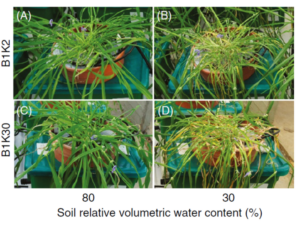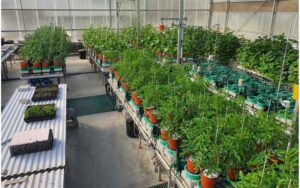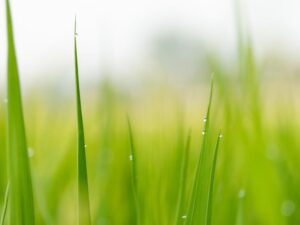Drought stress in plants is one of the most critical environmental challenges threatening global agriculture and food security. Limited water availability severely affects plant growth, development, and yield. Understanding plant responses to drought stress and identifying mechanisms of drought stress tolerance in plants are essential for developing resilient crop species in an era of climate change.
What Are the Physiological Effects of Drought Stress?
When plants experience drought conditions, water deficit triggers multiple physiological changes. Reduced leaf water potential leads to stomatal closure, which limits transpiration but also reduces CO₂ uptake, thereby suppressing photosynthesis. Prolonged drought stress in plants often results in reduced leaf expansion, premature leaf senescence, and inhibited cell division.
For instance, Flexas and Medrano (2002) reported that drought stress in grapevines significantly decreased photosynthetic efficiency due to stomatal closure. Similarly, Chaves et al. (2009) demonstrated that drought-induced limitations in gas exchange are a primary factor in yield reduction across many crops.

How Do Plants Respond to Drought Stress on a Biochemical and Molecular Level?
Plant responses to drought stress involve complex biochemical and molecular pathways. One of the primary defense mechanisms is the accumulation of osmolytes such as proline, glycine betaine, and soluble sugars, which help maintain osmotic balance and protect cellular structures.
On the molecular level, drought triggers the upregulation of stress-responsive genes, including those encoding dehydrins and late embryogenesis abundant (LEA) proteins. Hormonal regulation, particularly abscisic acid (ABA), plays a central role by signaling stomatal closure and activating drought-responsive transcription factors.
A well-documented example is the role of the DREB (Dehydration-Responsive Element Binding) transcription factors, which regulate downstream genes associated with drought stress tolerance in plants (Yamaguchi-Shinozaki & Shinozaki, 2006).
Which Morphological Adaptations Enhance Drought Stress Tolerance in Plants?
Beyond biochemical changes, plants develop structural and morphological adaptations to enhance drought stress tolerance. Root system architecture is a key factor: plants with deeper or more extensive root systems can access water from deeper soil layers.
For example, Lynch (2013) highlighted that maize varieties with improved root angles and elongation rates demonstrated better drought avoidance strategies. Leaf rolling, cuticle thickening, and reduced leaf area are additional morphological traits observed in drought-stressed plants.
These adaptations showcase the diversity of evolutionary strategies plants employ to withstand water scarcity.

How Do Specific Crops Respond to Drought Stress?
Several crop species have been studied for their drought stress tolerance in plants:
- Rice (Oryza sativa): Drought stress significantly impacts rice, especially during flowering. Studies by Serraj et al. (2011) showed that breeding programs targeting deeper rooting traits improved rice resilience.
- Wheat (Triticum aestivum): Wheat demonstrates strong osmotic adjustment capacity, and selective breeding has improved its drought tolerance under Mediterranean conditions (Blum, 2011).
- Soybean (Glycine max): Soybean plants subjected to water deficit displayed increased proline accumulation and antioxidant enzyme activity (Manavalan et al., 2009).
These examples underline the importance of species-specific research to enhance drought tolerance in staple crops.

What Are the Future Directions and Agricultural Implications?
Addressing drought stress in plants requires integrating physiological, molecular, and agronomic approaches. Advances in genomics and biotechnology enable the identification of drought-tolerance genes and their introduction into elite cultivars. Furthermore, precision agriculture techniques, such as soil moisture monitoring and optimized irrigation scheduling, can help mitigate drought effects in real-time.
Plant responses to drought stress are multifaceted, and enhancing drought stress tolerance in plants will be essential to securing global food production under increasingly unpredictable climate conditions.
Conclusion
Drought stress in plants represents one of the greatest threats to sustainable agriculture. Through physiological adjustments, biochemical defenses, morphological adaptations, and advanced breeding programs, plants have evolved mechanisms to cope with limited water availability. Strengthening drought stress tolerance in plants remains a top priority for ensuring food security in the face of climate change.
Ready to take your plant research to the next level? Discover how advanced phenotyping solutions from Plant-Ditech can help you accurately monitor drought stress responses, optimize breeding strategies, and accelerate the development of resilient crop varieties. Contact our team today to learn how real-time plant physiology insights can transform your research and improve drought tolerance outcomes.
References
- Blum, A. (2011). Plant Breeding for Water-Limited Environments. Springer.
- Chaves, M. M., Flexas, J., & Pinheiro, C. (2009). Photosynthesis under drought and salt stress: regulation mechanisms from whole plant to cell. Annals of Botany, 103(4), 551–560.
- Flexas, J., & Medrano, H. (2002). Drought-inhibition of photosynthesis in C3 plants: stomatal and non-stomatal limitations revisited. Annals of Botany, 89(2), 183–189.
- Lynch, J. P. (2013). Steep, cheap and deep: an ideotype to optimize water and N acquisition by maize root systems. Annals of Botany, 112(2), 347–357.
- Manavalan, L. P., Guttikonda, S. K., Tran, L. S. P., & Nguyen, H. T. (2009). Physiological and molecular approaches to improve drought resistance in soybean. Plant and Cell Physiology, 50(7), 1260–1276.
- Serraj, R., McNally, K. L., Slamet-Loedin, I., Kohli, A., Haefele, S. M., Atlin, G., & Kumar, A. (2011). Drought resistance improvement in rice: an integrated genetic and resource management strategy. Plant Production Science, 14(1), 1–14.
- Yamaguchi-Shinozaki, K., & Shinozaki, K. (2006). Transcriptional regulatory networks in cellular responses and tolerance to dehydration and cold stresses. Annual Review of Plant Biology, 57, 781–803.
Still Undecided? Let Us Help You Make an Informed Choice!
we understand that making decisions can be challenging, especially when it comes to important matters like plant phenotyping platform. We’re here to provide you with the guidance and information you need to make the best choice for you
1. You can read one of our many articles here: https://www.plant-ditech.com/references/academic-articles
2. Watch our customers testimonials: https://www.plant-ditech.com/references/case-studies
3. Watch our webinars in our YouTube channel: https://www.youtube.com/@plant-ditech8123
Or just contact us today by clicking the right tab and we will get back to you soon as possible









